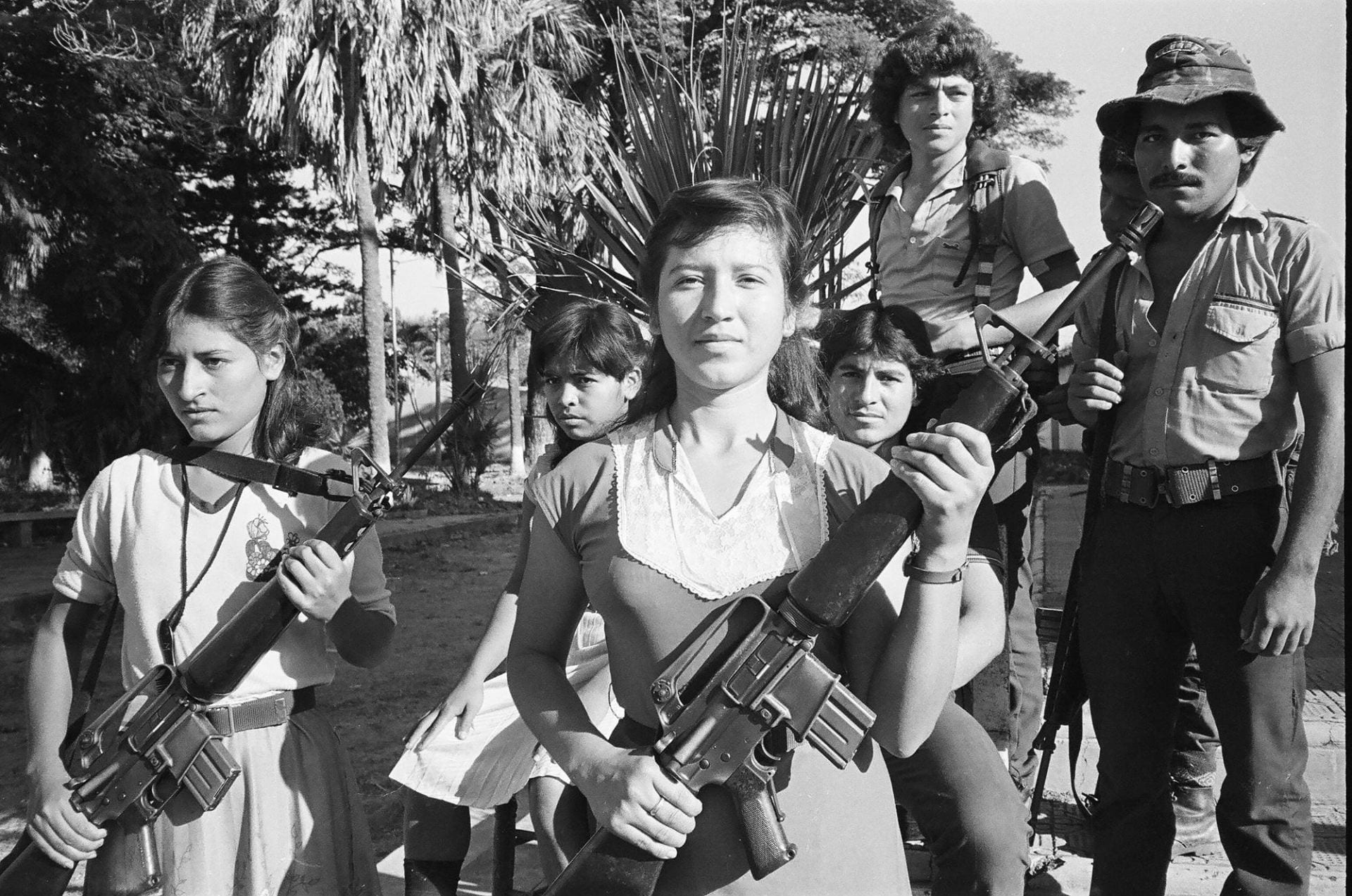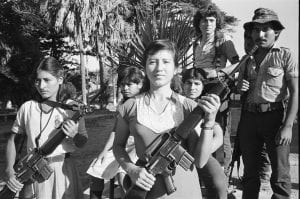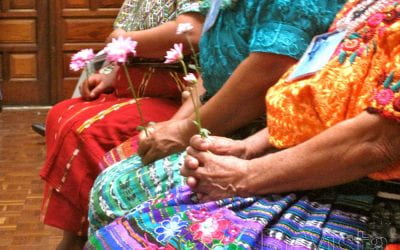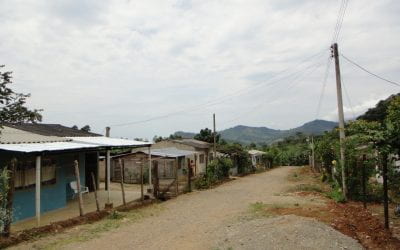Covering Central America in the 1980s
A Memoir in Words and Photos
The wipers slapped across the rain-smeared windshield as we sped through downtown San Salvador. Nelson Ayala clutched the steering wheel to keep us on the road through the torrential downpour. It was already two hours past dark, and it felt way too late to be out on the streets in this part of town.
Suddenly, a body appeared in the headlights just ahead of us, sprawled on the pavement. Nelson swerved to avoid it and kept going. “Shouldn’t we stop to help?” I asked. “It’s not convenient,” he replied, wagging a finger. “You don’t know who that person might be or why he is there. We’ll call an ambulance from the house.”
It was my first day in El Salvador, my first day as a professional reporter. I’d arrived that afternoon as a freelancer fresh out of journalism school, and with only $50 in my pocket, I’d made a beeline from the airport to the Camino Real Hotel, headquarters for the foreign press agencies covering the civil war. Most importantly, I had credentials from CBS News, and Nelson, the CBS driver whom I met in the network’s bureau, offered to put me up while I saved money and looked for a place of my own.
Nelson steered his Land Cruiser through a gate and into his garage just down the street from the motionless body. He made the call from an upstairs room and turned out the lights. Twenty minutes later, an ambulance silently approached, sirens off, its red strobe flashing in the rain. Two silhouetted figures stepped out, loaded the body into the vehicle, and drove off. “You have to be careful,” Nelson said didactically, like a grade-school teacher. “That person is dead for a reason. You stay away from dead people if you don’t want to end up dead yourself.”
This was my first lesson in how to survive in a war zone. For myself and a whole generation of young journalists arriving in Central America in the early 1980s, the armed conflicts in El Salvador and Nicaragua–and to a lesser extent Guatemala—were to become the crucible where we learned our trade and forged our careers. Many of us arrived as idealists, with passionate conviction that our work could make a difference.
We’d grown up with images of Vietnam on the nightly news, and we saw another Vietnam in the making in Central America. Perhaps through our reporting we could help stop a catastrophe before it happened. Public opinion mattered to U.S. officials. But as the conflicts throughout the isthmus intensified, we came to understand that reality wasn’t as black and white as we’d initially thought; it was far more nuanced.
Thirty years from my arrival in El Salvador in 1983, it seems an opportune moment to look back on those times and reconstruct how I—together with my colleagues—came to perceive the many shades of gray in the people, policies and events we covered. Indeed, what has happened in Central America in the ensuing years has confounded any predictions we could have made at the time.
I eventually found a small apartment in upper-class El Escalón, where interspersed among smaller middle-class homes were the walled mansions of coffee barons, factory owners, army generals and government ministers. These were impenetrable fortresses topped with guard towers, flood lights, barbed wire—the last lines of defense in a joint-venture of public and private capital and U.S. aid that stretched all the way out to the search-and-destroy units combing the hills of Morazán for the guerrillas of the Farabundo Martí National Liberation Front, or FMLN.
Across the narrow street from my place was a towering, garrison-style wall, with gun slits and peep slots through which a pair of eyes studied my comings and goings. I never met those neighbors. In fact, I never even saw them. They entered and exited through a steel gate in a bullet-proof Cherokee jeep with smoked windows, attended by a small army of men in aviator sunglasses and polyester suits bulging with Uzis, pistols and ammunition belts. Getting to know the neighbors was no easy feat in El Escalón. I had no idea that an academic lived on my block until he was already dead. I heard the report of guns in the night, not the burst of an automatic weapon, but the punctuated and deliberate single shots that betrayed a fatal intentionality. The following day my housekeeper told me that a professor two doors down had been found slumped over his desk. His live-in maid and gardener had also been executed.
Mostly I read about the unfortunates in the next day’s newspapers. Barefoot boys would thrust them through the car window at the intersections. I’d toss the kid a few grimy bills and speed off, horns blaring behind me, no time to wait for change. What caught my eye were the brief, tersely worded captions beneath the photos—black-and-white head-shots of extinguished life, streams of blood across their faces. The captions never changed; only the names: “Juan Perez, laborer, resident of Ilopango, ultimado —literally, “finished off” —last night in his home by unidentified men, heavily-armed and dressed as civilians, whereabouts unknown. The authorities remain ignorant of motive. An investigation is underway.”
Whatever prowess might have existed among El Salvador’s detectives was directed toward facilitating the extra-legal war effort. The investigators just signed the death papers; they didn’t want to know the details. Their reports were remarkably meticulous when it came to describing the wounds, the caliber of the bullets that produced them, and from what distance the weapons were fired. Most often, it was a quemarropa—point-blank range. The reports were equally remarkable for their failure to identify the perpetrators. It was as though you’d entered a world of Hitchcock’s creation, where black sorcery had staged a coup d’etat, and M-16s were invested with magical powers to appear at the location of their targets, aim themselves, and pull their own triggers.
Just being journalists made us suspect in the eyes of many. A full-page ad from the Secret Anti-Communist Army, a renowned death squad, denounced the U.S. press as “agents more dangerous and sympathetic to the terrorists than anyone in Moscow.” I smirked at the time, but I came to appreciate the logic behind such subliminal threats and how right those faceless people were, in their twisted way, how little Moscow really had to do with El Salvador; and how much we U.S. journalists did. The Soviets may have helped arrange some arms shipments from Hanoi or Tripoli via Cuba that eventually found their way to Chalatenango, but it was hardly the Ho Chi Minh Trail. In El Salvador, the Russians were totally peripheral to the conflict. But the government was completely dependent on U.S. aid, and our reports represented the only real counterweight to the flow of propaganda that helped sustain it.
The newly appointed defense minister, General Eugenio Vides Casanova, told his troops that the battle for American opinion was one of the war’s major fronts— “as important as San Vicente or Morazán.” The U.S. reporters covering El Salvador straddled both fronts. We found ourselves at the intersection where the war on the ground and the one back home converged. We were in its crosshairs.
A huge topographic map of El Salvador, 1:100,000 scale, sprawled across an entire wall at the CBS office in the Camino Real. Every bureau on the second floor had one, covered by clear plastic overlays smeared with grease pencils showing the zones controlled by the five rebel armies of the Farabundo Martí, zones that were up for grabs, Army garrisons, the alleged routes of arms smugglers. I would park myself in front of that map with its brown and green contours suggesting steep hollows and meandering brooks. There were countless hamlets with exotic names—Anamorós, Santa Clara, Yamabál—places where few, if any, reporters on the second floor had ever reached, places where I knew I’d find the war in all its living color and intensity.
No other country in Central America, much less any others locked in guerrilla war, made maps of such detail available to the public. They came in six separate pieces, and we began to carry them with us on forays into the countryside, a critical guide for exploring the war zones. But we had to keep them under wraps, not strewn out on the backseat. Being caught with them at a roadblock of either the army soldiers or the rebels was bound to spell trouble.
One afternoon, driving alone in brilliant sunlight, I turned off on to a back road toward the mountain-ringed village of Anamorós in far-eastern El Salvador. The rebels had overwhelmed the army garrison there days before, and I expected to run into them somewhere along that road. After consulting the map at the turnoff, I tossed it on the backseat and forgot it there, until a half-hour later, when I rounded a bend and saw a dozen or so armed men blocking the dirt road up ahead. I had no chance to turn back, no time to reach around and hide the map. The men were wearing black uniforms, with no insignias or shoulder patches, and they were waving me to a halt. Some of them had beards, not normal army protocol. But I’d heard that government soldiers had begun to operate in such a fashion, to confuse and intimidate.
I saluted them through the windshield, presented my army press credentials. I preemptively grabbed the map, spread it over the hood of the car, and said: “So tell me, brothers, what’s going on in the zone?” It caught them off-guard. “We’re on a sweep through here,” their evident leader said. “But what are you doing—looking for the terrorists?” It was no time for equivocation. “Not at all,” I replied with a touch of indignation. “My Colonel Cruz told me the army had regained control of the area, so I’ve come to have a look.” They let me pass, but I stuffed the maps under the seat and vowed never to get caught with them out in the open again.
Over time, alone and in the company of other reporters, I came to know the back roads and back towns of El Salvador better any comparably sized piece of real estate in the world. I knew where to find the guerrillas, where there was a high probability of running into an army sweep, which hamlets were ruled by jack-booted paramilitaries and which towns lived in a perpetual twilight zone— where neither the government nor the rebels had the strength to maintain a permanent presence. I liked to think that this knowledge enabled me to offer my readers more compelling and thorough reports than I could have otherwise provided.
The task of distilling and interpreting information was challenging enough for journalists covering a single country. But it was all the more complicated for those who covered the rest of Central America, particularly the Contra War in neighboring Nicaragua.
El Salvador’s civil war cut right across the country and into even the most well protected redoubts of the privileged. The conflict was everywhere. But in Nicaragua, the war unfolded deep in the backwoods. Unlike the FMLN in El Salvador, the Contras never managed to establish a serious urban presence. The main cities along the Pacific coastal plain, including Managua, were thus free from the war’s direct impacts. Under a trade embargo imposed by the U.S., there were severe shortages of goods, and funerals aplenty for officials and conscripts killed in the far-off battle zones. But Managua felt remarkably safe for the capital of a country in the midst of a war that was exacting a terrible toll in lives and treasure.
To cover the shooting war there, journalists had to venture deep into the countryside, often far beyond any settlements. Back roads were often sealed off by Sandinista Popular Army checkpoints, and it could take a measure of bluff to get past. Such was the case one July afternoon when Newsweek photographer Bill Gentile and I persuaded some young recruits to let us pass down a dirt road that snaked back into the mountains of northern Jinotega. Several hours later we found ourselves in Bill’s jeep wedged into a 40-truck military column ferrying an entire battalion of the Sandinista army into battle.
At dusk two evenings later, we witnessed the Sandinistas rake a Contra encampment with rockets and machinegun fire. When the operation resumed at dawn, the Contras had fled, leaving behind two dead and two wounded. The wounded sniped at the advancing troops from the brush, the Sandinistas screaming all the while for them to surrender. Neither of them did. It took more than a half-hour for the Sandinistas to overwhelm and subdue the two Contras. Their refusal to give in seemed to fly in the face of Sandinista propaganda: if the Contras were merely mercenaries in the pay of the U.S., as the Sandinistas contended, why would they fight to the finish as those two did?
The events that played out that morning added one more piece to the broader mosaic that I was constantly constructing in my head. First-hand experience is always the only real way to distinguish between information and its opposite. In the midst of claims and counterclaims from so many different sides, that ever-changing mosaic was my only guide toward an approximation of the truth. You had to keep in mind that your understanding was always tentative: at any turn it could be thrown off in a new direction if the next piece in your mental jigsaw puzzle didn’t fit where you were expecting it to.
Today the international reporters covering those distant wars are long gone. Daniel Ortega has returned to govern Nicaragua as head of a fractured Sandinista National Liberation Front, FSLN, after losing national elections three times. Throughout the 1980s, the nine-member FSLN directorate led by Ortega found wide sympathy for resisting President Ronald Reagan’s efforts to drive them from power by arming the Contra rebels and turning them loose in the Nicaraguan backwoods. Many of Ortega’s former comrades-in-arms are now his most vociferous opponents, alleging that he has subordinated Sandinista ideals to a self-serving quest for power.
The former guerrillas of the FMLN have attained power in El Salvador through the ballot box, embracing a far less radical approach than their Marxist forebears of the previous generation. But it will take years, perhaps decades, before Central America recovers from the intense violence that undid much of its social fabric.
We left a great deal of ourselves behind in covering these conflicts. And we left behind a highly skilled generation of Central American journalists to report on the ongoing aftershocks.
Related Articles
Educating the “Good Citizen”: Memory in postwar Guatemala
On my many field trips, I tell Guatemalan teens I’m interested in how they learn about the 36-year conflicto armado (armed conflict). I then study their faces. If not baffled, they avert their eyes and share refrains passed on by many adults in their lives: “We have no historical memory,” or “In Guatemala, there is no historical consciousness.” School teachers say, occasionally with concern, “We don’t talk about that here,” …
Displacement and Community Organizing: Shifting Memories and Identities Around a Mocoa Kitchen Table
We were having lunch at María’s house in Mocoa, Colombia, when it struck me how much the story of her past was shaped by the legal framework that defines her today as a victim, and when I first met her, in 2011, as an internally displaced woman. Over the extended year of our collaboration, I witnessed Maria’s subtle transformation to fit the shifting legal frame. …
Discovering Dominga: Adoptions and Tangled Truths
In the open central market one morning in Rabinal, Guatemala, 28-year-old Denese Becker picked up a bolt of corte cloth, woven fabric used by Achi Maya women to make their skirts, and brought it to her face. She closed her eyes. “My mother,” she said. “This smells like my mother.” I knew which one she was talking about….






